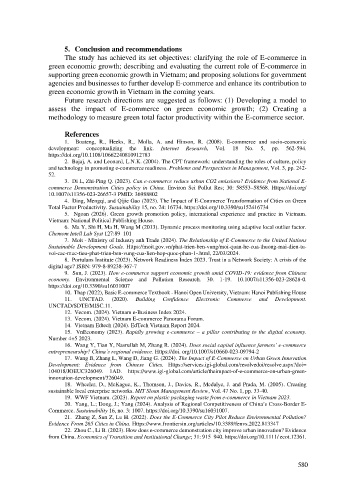Page 588 - Ebook HTKH 2024
P. 588
5. Conclusion and recommendations
The study has achieved its set objectives: clarifying the role of E-commerce in
green economic growth; describing and evaluating the current role of E-commerce in
supporting green economic growth in Vietnam; and proposing solutions for government
agencies and businesses to further develop E-commerce and enhance its contribution to
green economic growth in Vietnam in the coming years.
Future research directions are suggested as follows: (1) Developing a model to
assess the impact of E-commerce on green economic growth; (2) Creating a
methodology to measure green total factor productivity within the E-commerce sector.
References
1. Boateng, R., Heeks, R., Molla, A. and Hinson, R. (2008). E‐commerce and socio‐economic
development: conceptualizing the link. Internet Research, Vol. 18 No. 5, pp. 562-594.
https://doi.org/10.1108/10662240810912783
2. Bajaj, A. and Leonard, L.N.K. (2004). The CPT framework: understanding the roles of culture, policy
and technology in promoting e-commerce readiness. Problems and Perspectives in Management, Vol. 3, pp. 242-
52.
3. Di L, Zhi-Ping Q. (2023). Can e-commerce reduce urban CO2 emissions? Evidence from National E-
commerce Demonstration Cities policy in China. Environ Sci Pollut Res; 30: 58553–58568. Https://doi.org/
10.1007/s11356-023-26657-3 PMID: 36988802
4. Ding, Mengqi, and Qijie Gao (2023). The Impact of E-Commerce Transformation of Cities on Green
Total Factor Productivity. Sustainability 15, no. 24: 16734. https://doi.org/10.3390/su152416734
5. Ngoan (2026). Green growth promotion policy, international experience and practice in Vietnam.
Vietnam: National Political Publishing House.
6. Ma Y, Shi H, Ma H, Wang M (2013). Dynamic process monitoring using adaptive local outlier factor.
Chemom Intell Lab Syst 127:89–101
7. Moit - Ministry of Industry anh Trade (2024). The Relationship of E-Commerce to the United Nations
Sustainable Development Goals. Https://moit.gov.vn/phat-trien-ben-vung/moi-quan-he-cua-thuong-mai-dien-tu-
voi-cac-muc-tieu-phat-trien-ben-vung-cua-lien-hop-quoc-phan-1-.html, 22/03/2024.
8. Portulans Institute (2023). Network Readiness Index 2023. Trust in a Network Society: A crisis of the
digital age? ISBN: 979-8-89238-367-7
9. Sun, J. (2023). How e-commerce support economic growth amid COVID-19: evidence from Chinese
economy. Environmental Science and Pollution Research. 30. 1-19. 10.1007/s11356-023-28628-0.
https://doi.org/10.3390/su16031007
10. Thap (2022), Basic E-commerce Textbook - Hanoi Open University, Vietnam: Hanoi Publishing House
11. UNCTAD. (2020). Building Confidence Electronic Commerce and Development.
UNCTAD/SDTE/MISC.11.
12. Vecom. (2024). Vietnam e-Business Index 2024.
13. Vecom. (2024). Vietnam E-commerce Panorama Forum.
14. Vietnam Edtech (2024). EdTech Vietnam Report 2024.
15. VnEconomy (2023). Rapidly growing e-commerce – a pillar contributing to the digital economy.
Number 4+5 2023.
16. Wang Y, Tian Y, Nasrullah M, Zhang R. (2024). Does social capital influence farmers’ e-commerce
entrepreneurship? China’s regional evidence. Https://doi. org/10.1007/s10660-023-09794-2
17. Wang B, Zhang L, Wang D, Jiang G. (2024). The Impact of E-Commerce on Urban Green Innovation
Development: Evidence from Chinese Cities. Https://services.igi-global.com/resolvedoi/resolve.aspx?doi=
104018/JOEUC326049. 1AD. https://www.igi-global.com/article/theimpact-of-e-commerce-on-urban-green-
innovation-development/326049.
18. Wheeler, D., McKague, K., Thomson, J., Davies, R., Medalye, J. and Prada, M. (2005). Creating
sustainable local enterprise networks. MIT Sloan Management Review, Vol. 47 No. 1, pp. 33-40.
19. WWF Vietnam. (2023). Report on plastic packaging waste from e-commerce in Vietnam 2023.
20. Yang, L.; Dong, J.; Yang (2024). Analysis of Regional Competitiveness of China’s Cross-Border E-
Commerce. Sustainability 16, no. 3: 1007. https://doi.org/10.3390/su16031007.
21. Zhang Z, Sun Z, Lu H. (2022). Does the E-Commerce City Pilot Reduce Environmental Pollution?
Evidence From 265 Cities in China. Https://www.frontiersin.org/articles/10.3389/fenvs.2022.813347
22. Zhou C., Li B. (2023). How does e-commerce demonstration city improve urban innovation? Evidence
from China. Economics of Transition and Institutional Change; 31: 915–940. https://doi.org/10.1111/ ecot.12361.
580

